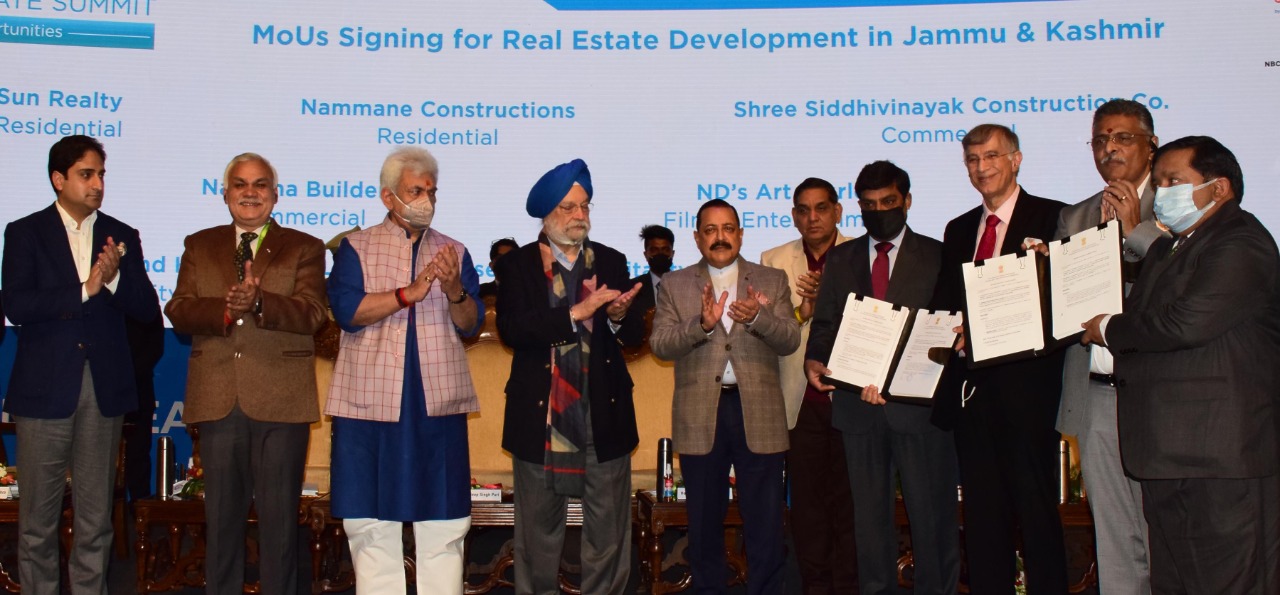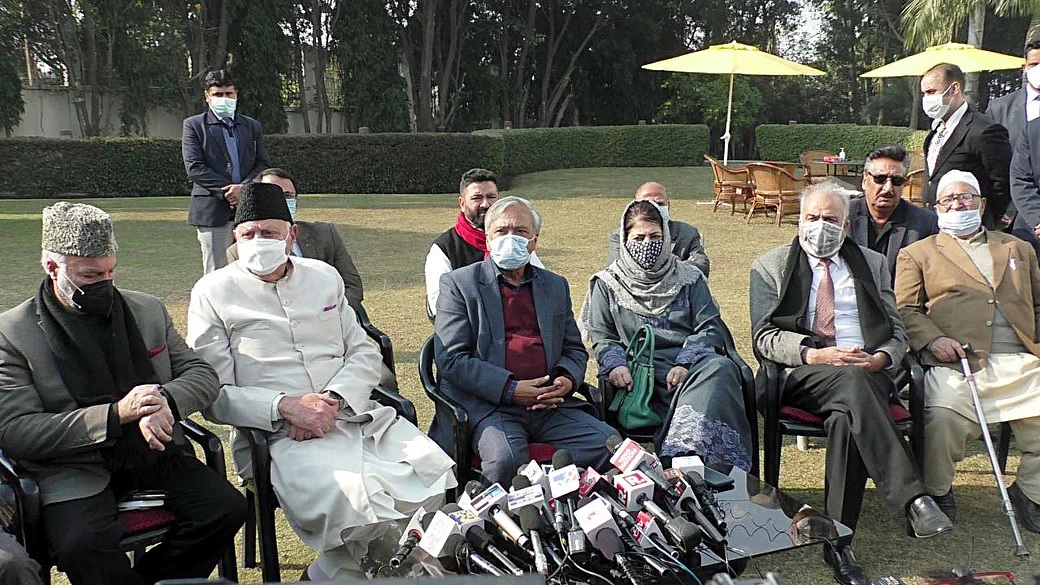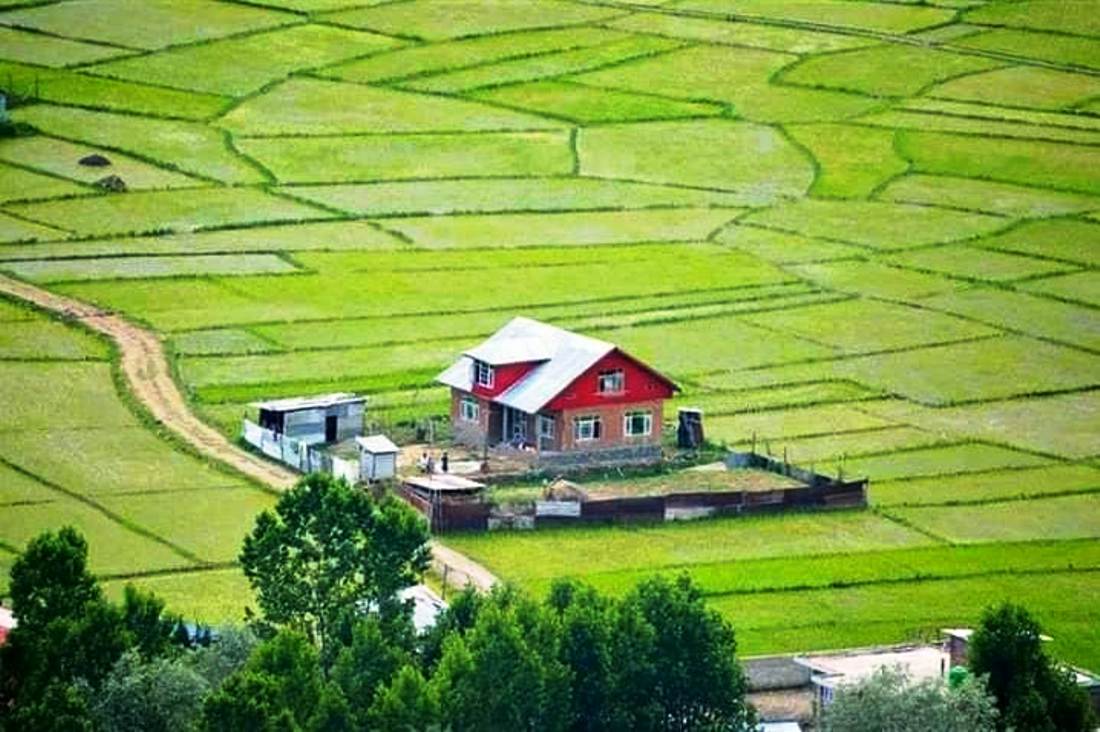Almost 14 months after the Jammu and Kashmir’s historic land laws basket was hugely altered by binning some and changing many, the administration finally opened the erstwhile state to the investment in the real estate sector. The move that marked the end of protection to land resources for the first time since 1927, triggered scathing criticism from the political class, reports Masood Hussain

Jammu and Kashmir felt pushed to the edge when the Ministry of Home Affairs (MHA) massively changed the land laws on October 26, 2020, a year after converting the erstwhile state into two Union Territories (UT). As many as 12 laws were repealed and 14 were amended under the UT of Jammu and Kashmir Reorganisation (Adaptation of State Laws) Fifth Order, 2020, less than a week before its powers to independently amend the J&K Re-Organisation Act, 2019 would cease to exist. It impacted the entire land law basket including the land reforms and the laws governing sale and purchase, thus ending the protection of land resources that Jammu and Kashmir enjoyed since 1927.
In the land law basket, four laws were of key importance: the Jammu and Kashmir Alienation of Land Act, 1938; the Big Landed Estates Abolition Act, 1950; the Jammu and Kashmir Land Grants Act, 1960; and the Jammu and Kashmir Agrarian Reforms Act, 1976. All four laws upheld a “permanent resident’s” right to hold land. The MHA order abolished the first two laws. In the remaining two, the “permanent resident” clause was deleted without offering a domicile as a substitute thus allowing the purchase of land by any individual living across India.
The abolished laws marked the undoing of the historic struggle of the people for retaining rights over their land source, part of their identity. The Big Landed Estates Abolition Act of 1950 gave the government the authority to confiscate land exceeding 22.75 acres. The excess land was distributed among farmers tilling the same land.
The Jammu and Kashmir Agrarian Reforms Act of 1976, which was also abolished, had reduced the possession of land by a person to 12.5 “standard acres” (excluding orchards). The Jammu and Kashmir Common Lands (Regulation) Act, 1956, which gave adjoining landowners a right in the use of shamilat land, or village commons, was also done away with.
The order ensured sweeping changes through the Jammu and Kashmir Development Act of 1970 that permitted the creation of notified “development zones” bypassing all other land laws. Effectively taking over the Jammu and Kashmir Land Acquisition Act, 1990 (that prevented allotment of land to a non-state subject for residential purposes), the Development Act envisages the creation of a powerful Jammu and Kashmir Industrial Development Corporation (JKIDC) for the establishment of industries, and “commercial centres”. The corporation, apparently a state within a state, can purchase, sell and lease land, construct houses and commercial establishments, and can hoard the land resource. It can also designate “strategic areas” for armed forces within the lands it holds on the request of a Corpse Commander.
Besides, the MHA extended three Central laws including the Real Estate (Regulation and Development) Act, 2016. Sweeping interventions in the Jammu and Kashmir Land Revenue Act, 1996, led to the creation of the Board of Revenue that will dictate the use of land and water. Even contract farming was permitted in Jammu and Kashmir.
Fierce Reaction
The intervention led to a hue and cry. Cutting across party lines, the political class in Kashmir and Jammu sought safety to protect peoples’ rights over the land resource. NC and PDP said the interventions have put Jammu and Kashmir was on sale and others said it was a betrayal with the people. Separatists saw an element of “demographic shift” in the policy intervention.

In response to this loud shouting, Lt Governor, Manoj Sinha accused the “vested interests” of creating a “false narrative” and insisted that not an inch of agricultural land is being touched. “I want to say this forcefully and with full responsibility that agricultural land has been kept reserved for farmers; no outsider will come on those lands,” Sinha said on October 27, on the sidelines of the Infantry Day at the SKICC in Srinagar.
Early November, Rohit Kansal, the spokesman for the Jammu and Kashmir addressed a news conference in which he was asked about the land law changes. “The new land laws will not only afford protection to over 90 per cent of the land in Jammu and Kashmir from being alienated to outsiders but will also help revamp the agriculture sector, foster rapid industrialization, aid economic growth and create jobs,” Kansal said, insisting the repealed laws were “ old, regressive, intrinsically contradictory and outdated.”
Kansal had his own justification. Some of the laws, he said, were contradicting each other, thus leading to scope for discretionary interpretation and rent-seeking. “Family was defined differently in different laws; provision of alienation and conversion of land were different in different laws and the ceiling of 182 kanals fixed in Big Landed Estates Abolition Act was superseded by 100 standard kanals in the Agrarian Reforms act, 1976 and both the laws coexisted,” he said.
Kansal said the new set of laws were progressive, almost at par with neighbouring states and would offer “adequate protection against alienation of land to outsiders.”
Altering Land Use
As new orders continued being issued, the controversy took a back seat till December 16, 2021, when the Jammu and Kashmir Administrative Council (AC), the de facto cabinet of Lt Governor Manoj Sinha, met in Jammu to discuss an extra-ordinary agenda. It had to approve the new set of regulations recommended by the Board of Revenue, a group of hugely empowered officers led by the Financial Commissioner (revenue).

The government spokesman said the regulation was necessitated in wake of managing some balance between the “uncontrolled” conversions of agricultural land for non-agricultural purposes on one hand and managing the “developmental aspirations” of the people. The AC finally authorised the Deputy Commissioner’s to permit the change of land use pattern from agricultural to non-agricultural purposes within 30 days of the application is filed. The permission will be presumed to have been granted if the Deputy Commission is not taking a decision in 30 days.
The collectors’ were given an authority to permit land-use change to the maximum of 12 and a half “standard” acres against a fee of 5 per cent of the market value of the land notified under the Stamps Act. Within a year, the applicant must commence the land’s non-agricultural use. Termed to be a reform, the spokesman said the intervention would take Jammu and Kashmir at par with other states in allowing the conversion and reducing compliance burden under the Business Reforms Action Plan (Ease of Doing Business) in an investor-friendly eco-system.
A Generational Shift
The intervention changed the age-old system in vogue in Jammu and Kashmir. “There are various things that have changed now,” Latief u Zaman Deva, a former senior revenue officer who retired as a member of the Jammu and Kashmir Public Service Commission (PSC) said. “Firstly, the Deputy Commissioner was authorised to alter the land use (only in urban areas) to the maximum of ten marals (half a kanal) and beyond that, it was the government that retained the authority. Secondly, the earlier post-August 2019 assertion that no non-local can hold agricultural land got annulled. Thirdly, it is not known on which grounds the Deputy Commissioner can alter the land use and what the grounds could be on basis of which he can refuse the same.”
The decision over whether a parcel of land can have an alternative usage was always the prerogative of the political executive, Deva said, insisting it has now moved to the officialdom. What is also interesting is that the area involves a “standard acre” and not an ordinary acre (normally eight kanals). “The standard acre was defined in detail in the Land Reforms Act and can have different measurements in five different kinds of land,” Deva said. “While 12.5 standard acres could be 72 to 78 kanal in Abi Awal, it can go beyond 800 kanals in case of uncultivable lands.”
Deva said the new laws do not offer any idea about how to prevent a distress sale when the government is interested in a deal. The problem in Jammu and Kashmir, Deva pointed out is that the land holdings in Jammu and Kashmir are lowest because there is no land.
Shrinking Landholdings
An agriculture survey takes place almost every five years. This offers an idea about what is happening with the landholdings – how the sizes are falling and the numbers of owners increasing. The 2005 survey suggested that 69.49 per cent of landholdings in Kashmir (Ladakh included) were less than half a hector (one hector is 20 kanals) each; 20.39 per cent were up to a hector as 7.86 per cent were between one and two hectors. In comparison, Jammu was slightly better with 46.51 landholdings falling up to half a hector, 24.4 per cent up to one and 17.86 per cent were between one and two hectors.
In 2010, Kashmir had 72.9 per cent landholdings measuring up to half a hectare each, 17.72 per cent were up to hector and 7.18 were between one and two hectares. For Jammu, it changed to 52.48 per cent, 22.57 per cent and 16.56 per cent, respectively.
Five years later, in 2015, it changed marginally – 72.16 per cent, 18.53 per cent and 7.21 per cent in the case of Kashmir and 51.38 per cent, 22.58 per cent and 16.94 per cent in the case of Jammu. Interesting to mention that in 2015, in Kashmir there were only 89 landholdings with a 10-20 hector size and only 56 above it.
The number of landowners continues to change. In 2005, of the 1377808 landowners, 769352 were in Kashmir and 608456 in Jammu. Five years later, the overall number of landowners had increased to 1449397 with 644175 in Kashmir and 646175 in Jammu. The surveys counted 1416509 landowners in 2015 of whom 795468 were in Kashmir and 621041 were in Jammu. Fall in the number of landowners essentially means that the owners had petty landholdings so might have sold it.
The diminishing size of the landholdings is a key economic factor as it triggers people out of the village settings to seek jobs in urban and suburban spheres. Already, Kashmir has undergone a massive shift in land use with people shifting from paddy to apple and other cash crops thus impacting food security.
Tensions Mount
Yet again, the political class was afire. Mehbooba Mufti termed the land conversion system a revelation of “nefarious designs of engineering demographic changes” using development agenda a “ruse”. Regretting that the new land ownership through the conversion mechanism would not even require a domicile certificate, she said, it furthered the disempowerment process set in motion in 2019.
Omar termed it “another nail in the coffin” of the landmark ‘land to the tiller’ reforms, which will now threaten food security. Apni Party termed the decision “arbitrary” that will fuel alienation.
The Real Estate
The naya Kashmir policy making, however, did not stop. On December 27, the LG Sinha hosted Hardeep Singh Puri and Dr Jitendra Singh and “titans” of India’s real estate sector at the 2-day Real Estate Summit at Jammu where 39 MoUs were signed that would pave way for investment worth Rs 18,300 crore in Jammu. A similar summit is lined up for Srinagar in May 2022.
No independent reportage is available about the summit other than the statement issued by the administration spokesman that suggested 19 MoUs pertained to residential structures, eight commercial, four in the hospitality sector, three each for infrastructure and films and two in finance.
Those who have signed the MoUs included Signature Global, Samyak Group, Raunak Group, Hiranandani Constructions; NBCC for housing projects; Chalet Hotels; Raheja Developers, Goel Ganga, GHP Group and Shree Naman Group.
Clear details were available about the Apollo Hospitals that intends to set up a 250-bed multi-speciality hospital in Jammu. Dr Preetha Reddy, the Executive Vice Chairperson of the Apollo Hospitals said their investment will create more than 1000 direct jobs.
Sinha Speaks
“There is a demand of up to 3 lakh units in housing and hotel segments,” Urban Housing minister, Hardeep Singh Puri told the audience. (Projected indigenous housing demand stood at 2.5 lakh dwelling units of which almost 30 per cent is in urban areas.) “The UT has the land and also the demand for real estate development, he pointed out.”

Insisting that the “culture of last 60-70 years (has) made us slaves of mind”, Dr Jitendra Singh said the Summit is an “important link to connect it (Jammu and Kashmir) to mainstream India”.
Host LG Sinha talked about the religious texts that give huge importance to having a home. He said the summit is aimed at that. “Every person has a dream to have a house and I think here (in Jammu and Kashmir) there are many possibilities. Here, the people of Kashmir want to have a home in Jammu for winters. And people of Jammu and other parts of the country want to have a house in Srinagar so that they can enjoy its beauty in the summers and find respite from the heat,” Sinha added. “There are Vrindavan-like (a city of temples on the banks of Yamuna in UP) locations in Jammu and Kashmir. Many people from Punjab, Haryana and Himachal Pradesh want to have a house or flat in Kathua so that they could come for a few days and visit the Mata Vaishno Devi Darshan. There are many places for people who adhere to Islam as well here. We welcome you to Jammu and Kashmir.”

Talking about the “hurdles” in bringing investment to Jammu and Kashmir before August 5, 2019, Sinha said those walls “have now started crumbling”. Regretting that people (a reference to the political class of Kashmir) discouraged development, Sinha said: “They want industries without giving land for it and development without investments. But we will break all walls that will come in the way of Jammu and Kashmir.”
He told the media that his administration has already identified 6,000 acres of land for industrial investment and this land will be also available for the real estate builders from outside to construct housing colonies. Soon, he said, there will be Sainik Colonies in Srinagar. The potential investors, he said assured him that they will take local partners so there is no possibility of a demographic change.
“The government land at our disposal – be it belonging to Jammu Development Authority (JDA) or Srinagar Development Authority (SDA), will be given to the real estate sector,” Sinha explained. “We have also put related laws in place if they (investors) want to develop housing colonies even after buying private land. The landowners will be given an option to go for the best deal of their choice.”
“To facilitate transparent and accountable framework in the real estate sector, we have launched many portals – RERA portal, housing portal, integrated auction portal. Such initiatives will help both developers and home buyers as a one-stop portal for all their needs,” Sinha told the audience.
Political Class Reacts
The response from ground zero, however, came through the political class, which is also battling for space. Former Chief Ministers Omar Abdullah and Mehbooba Mufti termed the objectives of the summit to be the change in demography.
“Once again the true intentions of the Government are brought to the fore. While offering to secure the land, jobs, domicile laws & identity of the people of Ladakh, J&K is being put up for sale. People of Jammu should beware, ‘investors’ will buy up land in Jammu long before Kashmir,” Omar Abdullah tweeted. Added Mehbooba: “J&K’s special status was illegally revoked to dehumanise, dispossess & disempower the only Muslim majority state in India. GOIs brazen loot & sale of our resources shows that the sole motive is to annihilate our identity & change the demography.”
Even the parties seen as sympathetic towards the ruling BJP were not supportive. Apni Party founder Altaf Bukhari said the effort “aimed at a holistic development and job creation” were welcome “but not at the cost of domicile laws that safeguard land and employment rights of its permanent residents”. His party wanted to formally protest but was not permitted. He told reporters that his party has pledged that it will resist any plans that will do away with the exclusive rights of the people on their land and jobs.
Insisting that it was aimed to “annihilate our identity”, Communist leader, Yousuf Tarigami, who speaks for PAGD, said the undoing of land reforms was the key reason for low levels of poverty. The summit, he said, has “rekindle (d) fears about the motives behind such decisions.”
BJP, obviously, was happy. “There is an urgent need to create an optimal convivial atmosphere in this infested region of terrorism to help young people,” former deputy chief minister Kavinder Gupta is quoted. “If the government of the NC has taken initiatives in the past to install Pakistani residents, then why are they now opposed to the so-called installation of the inhabitants of the nation who are likely to come and invest in Jammu- and Kashmir?”















